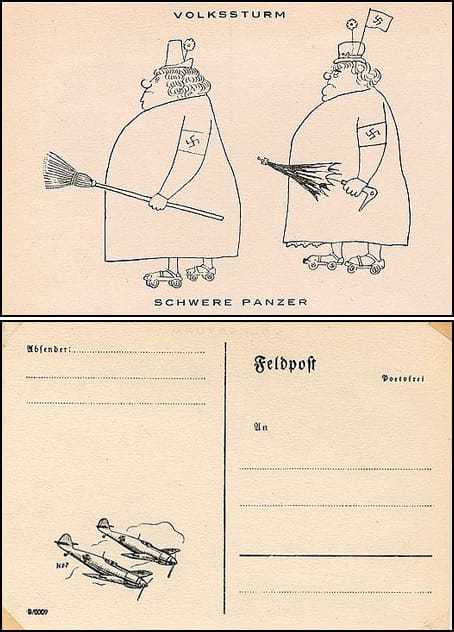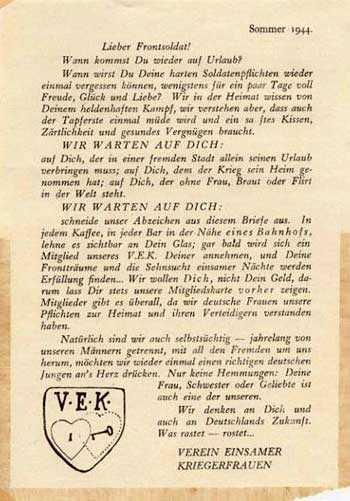It’s the summer of 1944. A weary German soldier stands guard on the front lines. An assassination attempt on Adolf Hitler has just occurred. A fellow soldier crossing the front lines shares a rumor of growing discord among the top German military. The soldier standing guard has no reason to suspect this information is false because it comes from a fellow German soldier … or so he thinks…
The Office of Strategic Services (OSS)—the predecessor of today’s Central Intelligence Agency—used “Black” or subversive propaganda during World War II to beat down the morale of the Axis troops. The Morale Operations (MO) Branch created the propaganda.
Cpl. Barbara Lauwers, a creative GI in the MO program, helped develop the propaganda programs intended to crush the spirit of the enemy. She participated in several successful missions during her two years with the OSS.
From Lawyer to Patriot
Lauwers was born in 1914 in Bozena Hauserova in what was then Czechoslovakia. She was a bright young woman and attended Masaryk University located in Brno to study law. After earning a doctorate in law, she became a practicing junior lawyer.
Lauwers soon married and moved to America with her husband in 1941. After the bombing of Pearl Harbor, Lauwers’ husband joined the U.S. Army. Lauwers followed in 1943.
“The truth was, I hoped the service would be a great adventure and I did not want to miss it,” she said.
On June 1, 1943, Lauwers became an American citizen. A few hours later, she joined the U.S. Army and was sent to Florida to begin training. After completing basic training, she was sent to the Women’s Army Corps officers’ school in Georgia. It was there that she was singled out for special service. Lauwers and two other women left immediately for Washington, D.C.
“Only upon arrival [in Washington] were we told that we were assigned to the OSS,” she said. “Immediately we were put through intensive indoctrination—work and keep quiet about it, mind your own business and don’t ask questions, be available 24 hours a day, seven days a week.”
Lauwers’ first overseas station was in Algiers, Algeria.

Operation Sauerkraut
After the Allied armies entered Rome on June 5, 1944, Lauwers was transferred to Italy. It was there that she became involved with Operation Sauerkraut. In the summer of 1944, Count Claus von Stauffenberg and some disillusioned German military officers attempted to assassinate Hitler. Hours after the attempt failed, the MO Unit initiated Operation Sauerkraut. Its goal was to attack the morale of the German army by circulating rumors, fake orders and leaflets about growing unrest among German military leaders.
Shortly after the assassination attempt, Lauwers found herself in a jeep headed toward a prisoners’ camp south of Naples. Lauwers’ role was to interview German prisoners, selecting a group to infiltrate the front lines and distribute the propaganda. She was chosen to interview the prisoners because she was fluent in German, English, Czech, Slovak, and French.
“When I was interviewing the prisoners, I was looking for dissidents who were willing to cross the front lines and distribute our propaganda,” Lauwers said.
Lauwers created new identities for the prisoners she selected and worked with them to memorize their stories.
Four days after the operation was launched, the German prisoners were ready for their mission. The prisoners dressed in German uniforms with the proper insignia and given forged identity papers, firearms with ammunition, survival supplies and 3,000 pieces of MO material. They were told to distribute the propaganda by nailing it to trees, leaving it in buildings, or scattering it through the streets.
The OSS declared Operation Sauerkraut a success. In addition to spreading the propaganda, the returning prisoners were able to bring back intelligence of great importance, including the location of some German troops. In fact, it was so successful that it became an expanded and ongoing operation for the duration of World War II in Italy, and later in France.

The League of Lonely War Women
As part of the ongoing Operation Sauerkraut, Lauwers was assigned to assist in producing the propaganda.
Lauwers was the only woman on the staff and was credited with inventing the “League of Lonely War Women” campaign, which sought to demoralize German soldiers with the belief that any soldier on leave could get a girlfriend by wearing a paper heart pinned to his lapel. The heart was the League’s symbol that appeared on a leaflet distributed to the Axis troops. If a soldier wore the heart symbol, a member of the League would approach him and offer her companionship. The goal of the campaign was to undermine Axis morale by insinuating that the soldiers’ wives or girlfriends were being promiscuous or unfaithful to them.
The propaganda was so believable that a prominent U.S. daily newspaper ran a story about it and credited the information to a circular confiscated from the Eighth Army front.

A Mission Worthy of a Bronze Star
Lauwers’ most successful mission involved producing propaganda that would convince several hundred Czech and Slovak soldiers forced into German service to cross over the front lines into Allied territory. The message was distributed via leaflets and a BBC broadcast to Northern Italy.
It worked. Six hundred Czechoslovak soldiers crossed the lines to the Allies, many of them carrying Lauwers’ leaflets in their pockets.
The success of this operation earned Lauwers a Bronze Star, which was presented to her on April 6, 1945 by the MO chief in Rome.
“I was told to put on my uniform and a little bit of lipstick and when we marched out, I was called to step forward,” she said. “Chills still run down my spine when I think about it.”

After the War
After World War II ended, Lauwers visited her family in Czechoslovakia before returning to the United States. She reconnected with her husband, only to find that they had grown apart. They divorced.
Lauwers’ post-war jobs included selling hats, working as a dental assistant, doing broadcasts for Voice of America, and working at the Library of Congress. It was at the Library of Congress that Lauwers met her second husband, Joseph Junosza Podoski—a Polish aristocrat who also worked at the library. He died in 1984 and Lauwers took his ashes to Poland, as he requested.
Examples of “Black Propaganda” produced by OSS Morale Ops:






